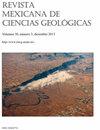米却肯-瓜纳华托火山区的硅质岩浆:管道系统、地壳储存和成因过程综述
IF 0.5
4区 地球科学
Q4 GEOSCIENCES, MULTIDISCIPLINARY
Revista Mexicana De Ciencias Geologicas
Pub Date : 2021-11-24
DOI:10.22201/cgeo.20072902e.2021.3.1668
引用次数: 8
摘要
Michoacán-Guanajuato火山场(MGVF)中的硅化岩的起源自火山场引起研究人员的注意以来一直研究不足。利用文献中的地球化学、岩石学和结构数据,我们提出了一个硅化岩浆起源的模型。我们发现,迄今为止,MGVF中已知的所有火山岩可分为40%的安山岩、33%的玄武安山岩、15%的玄武岩、2%的管玄武岩至管安玄武岩和10%的英安岩-流纹岩。使MGVF地壳变形的结构系统是渐新世期间发育的Taxco-San Miguel de Allende断层系统的NNW-SSE向正断层,以及渐新世-中新世期间发育的由ENE-SSW至E-W左旋走滑断层组成的Morelia-Acambay断层系统。除了文献数据外,我们还提出了一个重力磁力测量模型来研究岩浆获得最终硅化物成分的局部基底的特征,以及一个地震层析成像模型来研究有助于形成侵位在地表的硅化岩的深层管道系统。我们在MGVF文献中发现的唯一同化实验报告表明,斜长石和辉石比石英更容易被更热的岩浆消化。这些矿物相的消化对英安岩和流纹岩的生成有直接影响。我们提出,无论安山岩熔体的成因如何,这种中间岩浆都会到达上地壳,并被迫在局部挤压带内演化,在那里它们会融化局部花岗岩基底并形成晶浆。MGVF中硅化岩的成分变化是中间岩浆和花岗岩部分熔体之间可变混合的结果。本文章由计算机程序翻译,如有差异,请以英文原文为准。
Silicic magmas in the Michoacán-Guanajuato Volcanic Field: an overview about plumbing systems, crustal storage and genesis processes
The origin of silicic rocks in the Michoacán-Guanajuato volcanic field (MGVF) has been understudied since the volcanic field attracted the attention of researchers. Using geochemical, petrological and structural data from the literature, here we propose a model for the origin of silicic magmas. We found that all volcanic rocks known to date in the MGVF can be divided in 40 % andesite, 33 % basaltic andesite, 15 % basalt, 2 % trachybasalt to trachyandesite, and 10 % dacite-rhyolite. The structural systems that deformed the crust in the MGVF are NNW-SSE-oriented normal faults of the Taxco-San Miguel de Allende fault system, developed during the Oligocene, and the Morelia-Acambay fault system consisting of ENE-SSW to E-W sinistral strike-slip faults developed during the Oligocene-Miocene. In addition to bibliographic data, we present a gravimetric-magnetometric model to investigate the characteristics of the local basement where magmas acquire their final silicic composition, and a seismic tomography model to investigate the deep plumbing system that contribute to form the silicic rocks emplaced on the surface. The only report of assimilation experiments we found in the MGVF literature suggest that plagioclase and pyroxene are more easily digested than quartz by hotter magmas. The digestion of these mineral phases has a direct consequence on the generation of dacites and rhyolites. We propose that regardless of the genesis of andesitic melts, such intermediate magmas arrive to the upper-crust and are forced to evolve within local compression zones where they melt the local granitic basement and form crystal mushes. The compositional variability of silicic rocks in the MGVF is a consequence of the variable mixing between the intermediate magmas and the granitic partial melts.
求助全文
通过发布文献求助,成功后即可免费获取论文全文。
去求助
来源期刊

Revista Mexicana De Ciencias Geologicas
地学-地球科学综合
CiteScore
1.00
自引率
12.50%
发文量
0
审稿时长
6-12 weeks
期刊介绍:
Revista Mexicana de Ciencias Geológicas (RMCG) publishes original research papers on geological processes of broad interest, and particularly those dealing with regions of Latin America. The RMCG also publishes review papers on topics of current interest, and on the geology and tectonics of geological provinces of Latin America. Besides, it offers the opportunity for host editors to publish special thematic issues.
 求助内容:
求助内容: 应助结果提醒方式:
应助结果提醒方式:


